Black technician ‘unsung hero of op’

HAMILTON NAKI ,WHO WORKED ALONGSIDE CHRISTIAAN BARNARD WITH HIS SON AT THE LAUNCH OF THE VIDEO DOCUMENTARY MADE IN HIS NAME STORY MURRAY WILLIAMS PIC ENVER ESSOP 30 OCTOBER 2002 HAMILTON NAKI ,WHO WORKED ALONGSIDE CHRISTIAAN BARNARD WITH HIS SON AT THE LAUNCH OF THE VIDEO DOCUMENTARY MADE IN HIS NAME STORY MURRAY WILLIAMS PIC ENVER ESSOP 30 OCTOBER 2002
Francesca Villette
A black technician at UCT who performed transplants on animals during the same time Christiaan Barnard performed the first heart transplant was barred from operating on humans.
Hamilton Naki was born in the Eastern Cape in 1930.
His family was poor and, after completing school, he left for Cape Town in search of work.
According to South African History Online he was hired by UCT to maintain the tennis courts and in 1954 he was promoted to help with the care of laboratory animals.
He soon went on to being one of four technicians at the university and the black laboratory assistant to Barnard - a white cardiac surgeon.
Although Naki did learn how to perform transplants on animals in the laboratory, he was never involved in surgery on human subjects.
“Under apartheid Hamilton was disadvantaged because he was barred from working in the whites-only operating theatre and his contributions in the laboratory were largely unpublicised at the time,” the website reports.
In an interview with the BBC, Hamilton reflects: “Those days you had to accept what they said as there was no other way you could go because it was the law of the land.”
Nearly 40 years after Barnard made history with the transplant, stories began to surface about Naki's role in the procedure.
“Chris Barnard apparently hinted at Naki's involvement shortly before his death in 2001, and Naki himself claimed, at one stage, to have been involved more directly in the ground-breaking procedure.
Various publications went on to publish Naki's 'untold' story of his involvement at Groote Schuur.
They included The Economist and the New York Times (both June 11, 2005), and two interviews with Naki, one in the careers section of the British Medical Journal (BMJ Career Focus 2004) and one with BBC online.
But surgeons at Groote Schuur assured researchers and the media that Naki was nowhere near the operating theatre when the transplant was performed. As a black person during apartheid, and as a person with no formal medical qualifications, he was not allowed to be in the operating theatre, SA History Online reports.
– Francesca.villette@inl.co.za